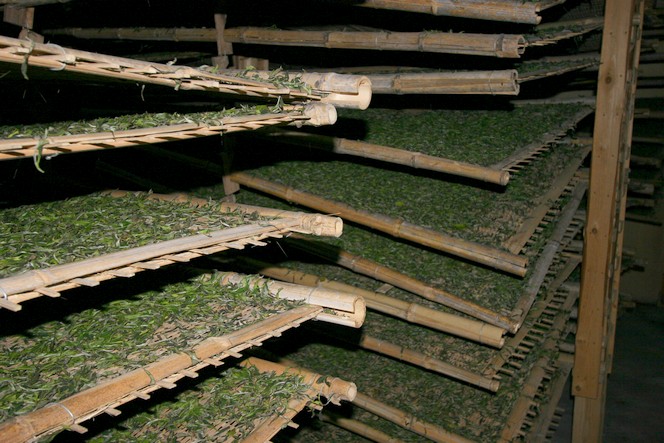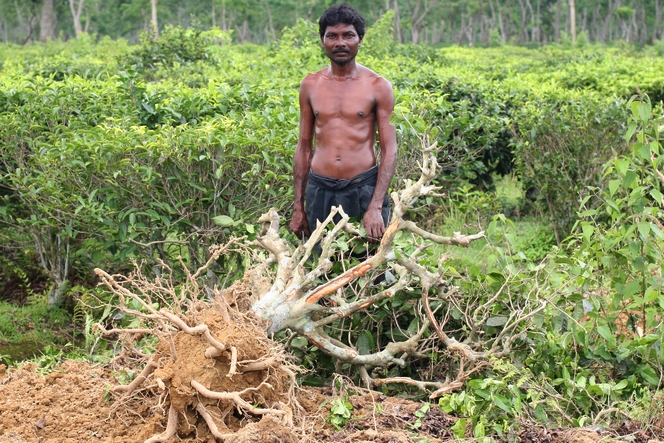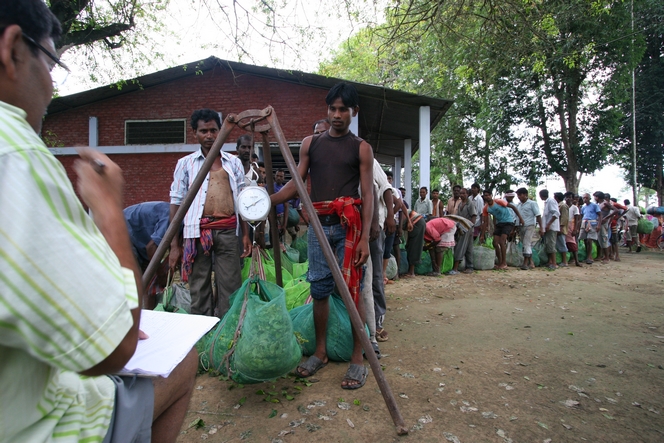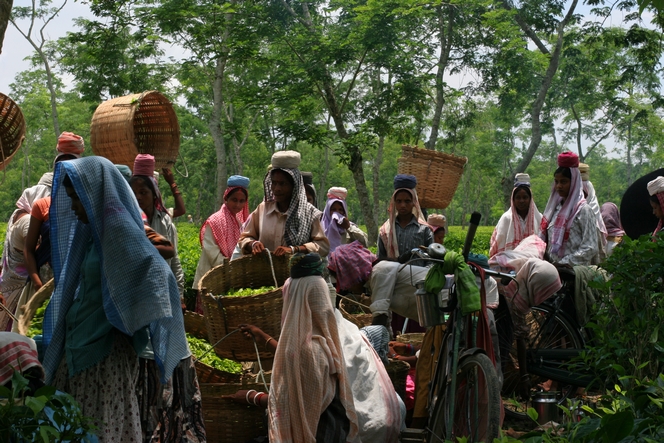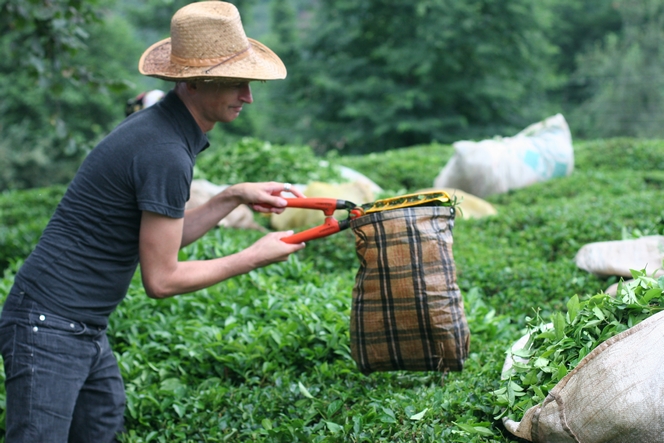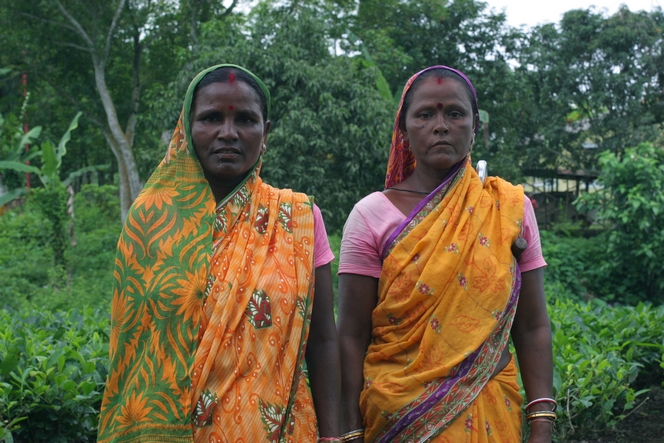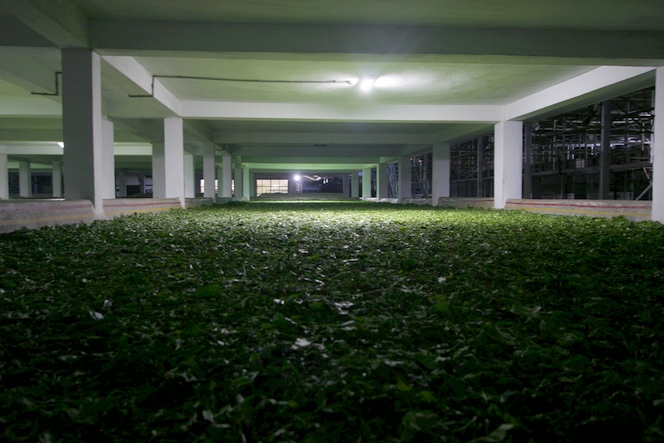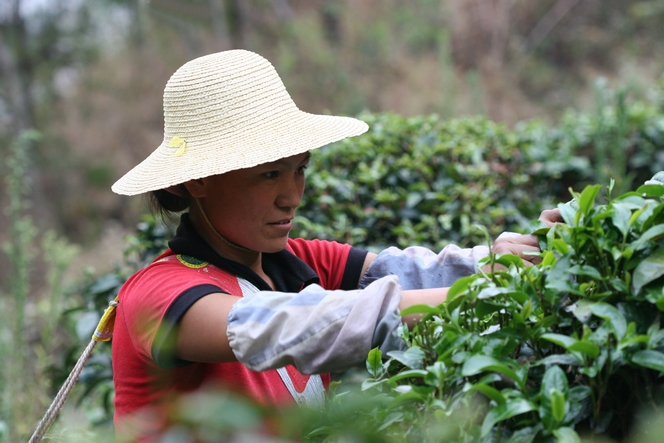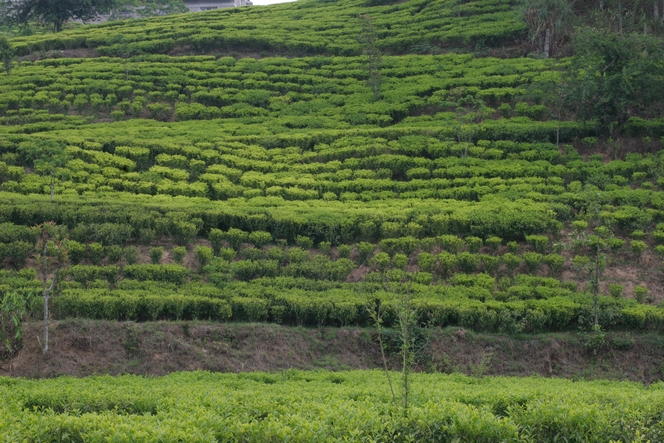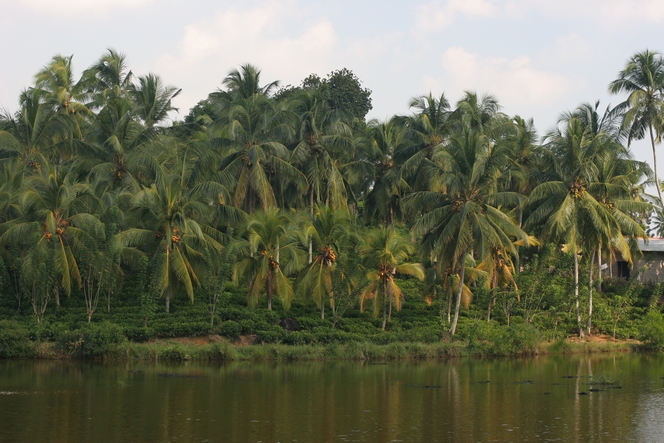In the past, the withering of tea leaves took place in the open air, but nowadays it increasingly happens in a heated, well ventilated room. This system offers greater control over the ambient conditions. Here, in Fujian (China), the temperature and humidity levels are carefully regulated, and the room benefits from a sophisticated ventilation system. Which means the leaves of this Bai Mu Dan can gradually lose their water content.
From plant to cup
Théier arraché sous une chaleur de plomb
Arracher un théier nécessite une force remarquable car ses racines plongent profondément en terre. Mais si l’homme que vous voyez ici transpire autant ce n’est pas du fait d’avoir réalisé cet exploit. Le théier vient en effet d’être déraciné par une pelleteuse et cet homme se contente de débiter la souche de l’arbuste à l’aide d’une machette. Il transpire de façon intense car la chaleur en Assam et le très fort taux d’humidité que l’on rencontre ici atteignent des sommets.
Ce qui me surprend le plus ici, du côté de Jorhat, c’est l’absence totale de vent. Durant des mois vous ne voyez pas une feuille d’arbre remuer dans cette région de l’Inde enclavée entre les hauts plateaux tibétains, au nord, et les montagnes birmanes à l’est.
Tea pluckers gathering to get their bags weighed
In the middle of the day, as soon as the plucking is finished, the workers gather to get their bags weighed.
Here, at Dufflating (Assam), everyone waits in turn and one by one hangs their bag of tea leaves on the mobile scales. The supervisor records the worker’s name and the weight of the bag, which will determine the pay for that day. You can see that the bags are made of netting, to prevent the leaves from oxidising. They must remain in perfect condition all the way to the factory, otherwise the tea will be spoiled.
Tea pluckers looking like queens
In Assam, as soon as harvesting is finished, the pluckers assemble, men on one side, women on the other, and they set off with their precious baskets to the place where they will be weighed. Some women hold their baskets under their arms, but most rest them on their heads. A rolled-up piece of cloth placed precisely on the crown of the head serves to support the basket. These splendidly colourful fabrics look like crowns, making their wearers look like queens, I think.
In Turkey, one uses clippers to pluck tea
In general, good tea should be plucked by hand. The leaf bud and the first two leaves on each stem are plucked between the thumb and index finger, with a precise, rapid movement.
It is best to avoid the use of clippers, although they are commonly used in some regions of the world where tea is produced with less emphasis on quality. Although the farmers in the Rize region of Turkey are very friendly, hospitable people, it has to be said that their harvesting methods massacre the tea.
Here, I have dared to give them a helping hand and I’m a little ashamed, I must admit, to be caught red-handed using their tool.
In Assam, there is a hierarchy in tea harvesting
There is quite a hierarchy among the people in charge of harvesting tea in Assam. This is true on the large plantations, anyway; there are also independent plots owned by small producers.
On the large plantations, the manager supervises the assistant managers, who organise the babus, whose role is to oversee the work of the sardars, who themselves are responsible for supervising the team of workers.
In this photo taken on the Dufflating plantation you can admire two sardars, who don’t look particularly approachable on first glance. But perhaps they are just reflecting, in their serious expressions, the position of authority they hold.
Tea leaves spread out as far as the eye can see
In Assam, anything related to tea processing takes place on a massive scale, because of the incredible yield they get here: four times higher than in Darjeeling. The plantations themselves cover a much larger area than elsewhere in the country.
Take the withering, for example. Instead of troughs 10 to 15 metres wide, which I am used to seeing in other parts of India, here the leaves are spread out as far as the eye can see. I took this photo at night, and the dim light adds to the mystery of this essential stage in tea processing. During the withering, the leaf will lose much of its water content (up to 40% for Assams; up to 70% for Darjeelings).
Camellia : a shrub with a tough foliage
In many countries, the men and women who pluck tea leaves wear a type of sleeve made from a light canvas, which covers part of the arm.
Camellia is quite a tough shrub, and at the end of the day, without this protection, which can be worn directly on bare skin or over the top of a garment, the pluckers’ arms would be covered in scratches.
I expect this young woman from Yunnan, who looks rather stylish beneath her straw hat, would agree.
Tea trees growing quite freely in Kuwapani
I am very aware of how lucky I am to be able to spend several months a year walking through tea fields. I never tire of it. Each tea plantation looks different. Some slope, others are flat, some are densely planted, others sparsely. Some are wooded, but the trees vary from one region to another.
What I like about this photo taken on Kuwapani Tea Estate (Nepal) is the contrast in these tea trees planted in rows that are quite orderly, yet which leave room for some interesting effects. The wavy lines follow the irregularities of the terrain, with a certain sense of freedom. They have adapted to their environment. We can see how the hand of man has marked out a neat line, and nature, rebellious, has ignored it.
Palm trees giving shade to tea plants
Here, in the south of Sri Lanka, in the “low grown teas” region, the sun is very intense, and it is best to protect the tea plants from its rays for at least a few hours a day.
Curiously, palm trees are used here to provide shade, despite being a rarity. As the palm trees themselves are cultivated, this enables the farmer who owns this lovely lakeside plot to harvest two different products on the same land, and both plants benefit.

